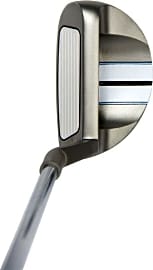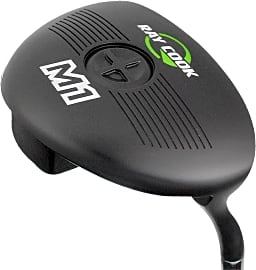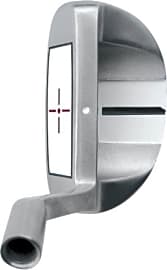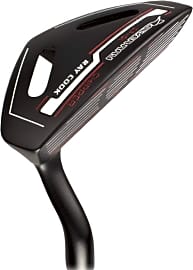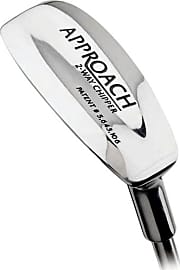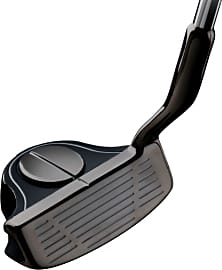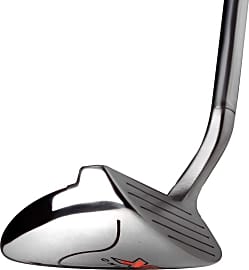The 9 Best Golf Chippers

This wiki has been updated 38 times since it was first published in October of 2016. When you're too far from the hole for a putt, but not confident you can stop a lob with a wedge, it's time to grab a chipper out of your bag. These clubs handle like putters, allowing for plenty of accuracy and control, yet produce enough loft to get balls out of any fringe or rough surrounding a green. Our ranking considers everything from aim-assisting features to surface texture. When users buy our independently chosen editorial choices, we may earn commissions to help fund the Wiki.
Editor's Notes
March 06, 2021:
Chippers are a bit of an odd club, as they have features of both putters and wedges, but are different enough from each so as not to fall firmly in either category. One thing you may notice when looking for a chipper is that many of the premium and most well-respected club makers don't sell them, which is why you don't see those names represented on this list for the most part. One notable exception is the Callaway Odyssey X-act Tank and, honestly, if not for its very high price, it would have scored a higher ranking here. That being said, if price is no object, it is probably the best choice thanks to the White Hot insert that provides the feel of a soft material, but plays like a harder one with a solid sound on contact.
Many golfers will also like the Wilson Men's Harmonized, as it plays very similar to a putter, so there is very little learning curve. This is quite opposite from the Intech EZ Roll, which has a steep learning curve because it really doesn't feel enough like a putter of wedge to be familiar for most players. That being said, its back-weighted design gives some nice follow through and consistency once you get comfortable using it. The Pinemeadow Golf Excel EGI also has a nice weight to it, without feeling heavy like the Acer XK.
April 18, 2019:
Chippers are a very unique club that fall somewhere between a putter and a wedge. While they may take some getting used to, once you get the feel of one, they allow for some deadly accuracy. If you need something that can produce a lot of lift, take a look at the Ray Cook Extreme Aim, Pinemeadow Golf Excel EGI, Paragon Sports LH, Ray Cook M1, and Acer XK, as these all have a 37 degree loft. If you prefer a lower arc on your shots, you'll probably want the JP Lann Golf Supreme, which has a loft closer to that of a six iron. The Wilson Men's Harmonized, Intech Approach Two-Way, Intech EZ Roll all have a middling loft of 34 or 35 degrees, which some feel is the perfect sweet spot. Just note, the Intech Approach Two-Way is not legal for tournament use because of its dual-face design.
How To Use A Golf Chipper
Stand so that the ball is slightly closer to your lead foot, and lean the majority of your weight over your lead foot.
Chippers, also sometimes referred to as putter chippers, are golf clubs that allow you to hit a short chip shot to pop the ball over the green's fringe. The head design is similar to that of a putter, except they have a slight loft, generally in the neighborhood of 30 to 37 degrees. They are the ideal club when tackling a shot that is too long for a putter, but too short for a wedge.
The first step in using a chipper correctly is to survey the ground between your position and the green to determine if a chipper is indeed the correct club to use. A chipper won't pop the ball as high as a wedge, so if there are any high obstructions, make sure you can realistically clear it with a chip stroke. Next, line up your shot in the same manner as you would a long putt. Take a moment to read the green to determine which direction the ball will break after it hits the ground and starts rolling.
When using a chipper, you should assume the same stance and grip as when using a traditional putter. Place your non-dominant hand close to the top of the grip and position your thumb so that it runs down the shaft. Then wrap your dominant hand over your thumb, positioning the thumb in line with the thumb of your non-dominant hand and interlocking the last finger of your dominant hand with the first finger of your non-dominant hand. Stand so that the ball is slightly closer to your lead foot, and lean the majority of your weight over your lead foot.
Use a normal putter stroke, keeping your wrists and elbows straight the whole time. Hit the ball just hard enough so that it pops into the air and over whatever obstruction is in your path. The swinging motion should be slow and smooth, with the force generated from your shoulders, not your arms. You should hit with slightly less force than you would if using a putter to hit a ball the same amount of distance. This is because a chipped ball encounters less friction and resistance than a ball that rolls the entire distance along the ground.
Choosing The Right Golf Chipper
When choosing your next golf chipper, there are a few things to take into consideration to ensure your purchase the best one for your needs. If you plan on using it for tournament play, make sure to pick one that has a single-face and a cylindrical grip. Some manufacturers sell two-faced chippers, which are fine for recreational play, but illegal according to tournament rules. There is nothing worse than spending hours improving your short game with a double-faced chipper only to find out you can't use it come tournament day.
Most manufacturers will note in the club's description whether it has a right hand or left hand orientation.
The angle of the club is also an important feature to take note of. Not all chippers have the same degree of loft. Some can hit the ball higher and farther than others. Take a look at the lofts of a few of your other clubs, including your sand wedge, eight iron, and nine iron. Ideally you want a set of clubs that offers you a lot of variety in loft. This way, you will always have just the right club for every shot. There is no point in having a nine iron and a chipper with the exact same loft. Instead, choose one that has a slightly higher or lower loft than your sand wedge and highest irons for maximum versatility.
As with any other golf club, it is important to choose a chipper that has the correct orientation for your playing style. Right-handed and left-handed players swing in the opposite direction, and each club is specifically designed for swinging in a particular direction. Most manufacturers will note in the club's description whether it has a right hand or left hand orientation. Make sure to also choose a club that is the proper length. The correct shaft length for each golfer depends on their height and the distance from their wrist to the ground. There are many sizing charts online that you can use to determine the correct chipper shaft length for you.
A Brief History Of Golf
The modern game of golf first started in 15th century C.E. Scotland, but according to most historians, older versions of the game have been around much longer. The Romans used to play a game known as paganica, which involved a stuffed leather ball, much like the first Scottish golf balls. The general belief is they used some form of bent stick to hit the ball, though there is some debate regarding this. During the Song Dynasty, which lasted from 960 to 1279 C.E., the Ancient Chinese played a game called chuiwan. This game, much like modern golf, involved using a club of some kind to hit balls into holes. These are by no means the only early games that bore some similarity to modern golf. The English played cambot, known in France as chambot, and the Dutch played kolven. All of these games had some similar aspects to what is found in modern day golf. For this reason, it is hard to deduce exactly from where the Scottish drew their inspiration.
Not long after golf became popular in Scotland, it was banned by King James II in 1457. He felt that it distracted citizens from more useful pursuits, such as archery and fencing. Despite it being illegal, many people would play openly at Saint Andrews, a sprawling grassland that eventually became one of the most popular golf courses in the world. In fact, the Open Championship, one of golf's oldest tournaments, is still held at Saint Andrews. It is also a popular tourist destination, drawing some 20,000 people a year who want to tour the original greens.
In 1502 C.E., King James IV lifted the ban on golfing, and in 1552, Archbishop John Hamilton declared Saint Andrews a public course. The oldest official golf course where the game has been played continuously is Musselburgh Links, in East Lothian, Scotland.



